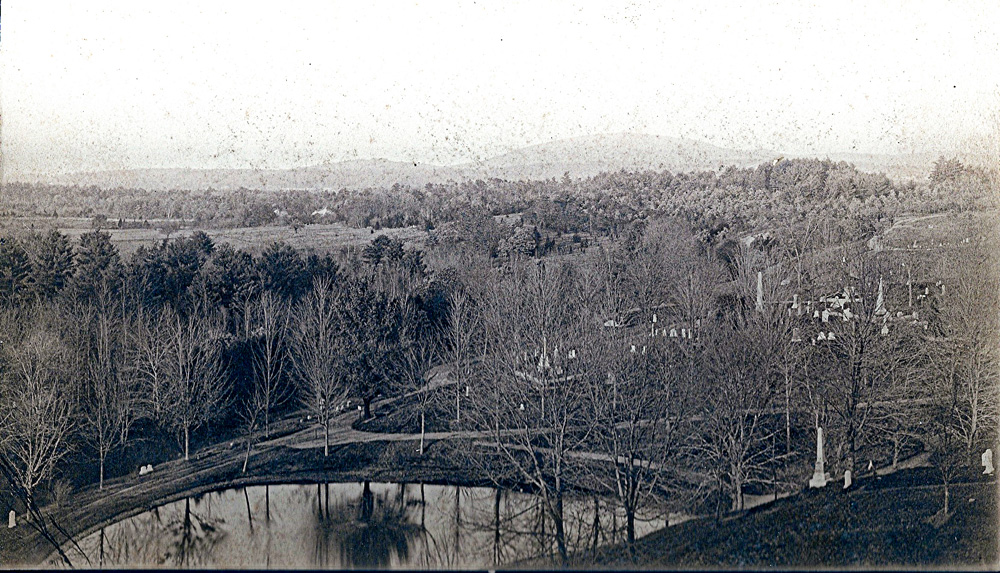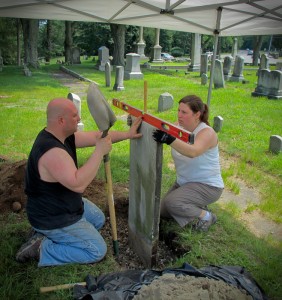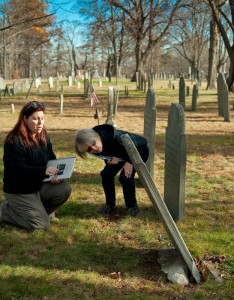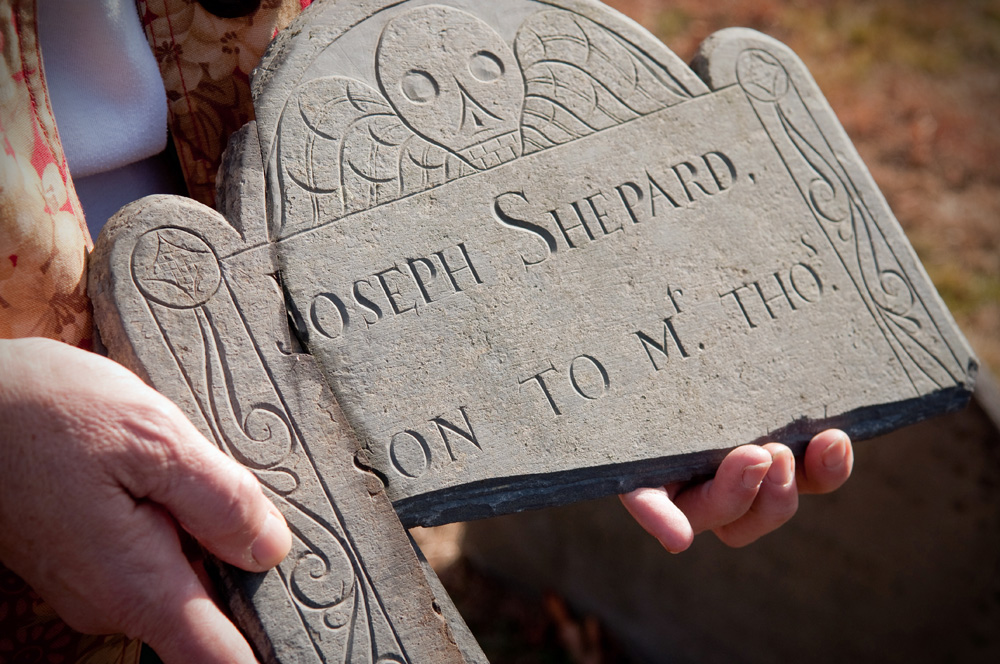True Tales: Preserving the common ground
By George T. ComeauLast Saturday was a beautiful day, and to be outside was especially wonderful. Wally Gibbs, the chairman of the Canton Historical Commission, convened a meeting in an unlikely place. We met under the arching leaves of an ancient oak tree on a winding path inside the Canton Corner Cemetery.
The purpose of the meeting was to begin to outline a preservation plan that will take dozens of years to accomplish, and quite honestly is the start of work that will never be finished. The members of the commission walked, talked, and witnessed the splendor and decay of the nearly 300-year-old public cemetery — perhaps the oldest in America still in use today.
It began in 1707 as one acre of land designated for burial. Then, Canton was known as Dorchester, and in 1707 the inhabitants petitioned the Great and General Court to establish a separate precinct so they could build a meetinghouse that would be convenient for the small village that was springing up in the vicinity of the Pakeen Plain. It is recorded that the Ponkapoag Indians who lived here “cheerfully relinquished all interests in the land.” While unlikely, the end result was that the Puritan settlers built a meetinghouse and an adjoining burying ground along the Boston to Rehobeth Road, now known as Washington Street.
The first burial occurred in 1716. The local expert on the Canton Corner Cemetery is Kathi Keith. It is her 1999 thesis for Radcliffe’s Landscape Design History program that begins our modern understanding of this national treasure. Keith writes that the cemetery “had a strategic location on a high flat plane with clear views of the valleys to the north and west. While meetinghouses and burial grounds were often sited on infertile soil, this was not the case in Canton … It is reasonable to assume that it was also used for pasture, particularly before the first burial in 1716.”
That first burial is easy to find: the 295-year-old headstone juts from the roots of a mighty Little-leaf Linden tree and is that of Gilburt Indicott. Covered with lichen, the stone tilts at an angle and is in an advanced state of decay. Indicott (or Endicott) was born in Dorchester around 1658 and served in the colonial military in 1676. Hostile Indians in Maine forced him to return to Dorchester, where he built a house at the corner of present-day Washington and Chapman streets. Indicott’s home was the first tavern in town, and his deed from the Indians granted him a 200-year lease to 100 acres of land, for which he paid £4 worth of “peppercorns.” In a word, he “stole” the land.
The Gilburt Indicott headstone is hard to read, but it is typical of early New England slate stones: arch-shaped, transformation symbol, a run hourglass indicating his time has passed, and a border of stylized leaves growing from scrolls, which has been interpreted as symbolic of scriptures. The tree that it stands under is slowly and surely pushing the stone up and out of the ground. And like hundreds of other markers, it is in danger of falling and splitting only to be lost to time.

A view of Canton Corner Cemetery with Blue Hill in the background, circa 1880s (Courtesy of the Canton Historical Society)
For 100 years the original one-acre cemetery served the small community, and by 1817 an additional acre was purchased to the west of the original burying ground. At a cost of $50 the community purchased land from Oliver Downes and created a committee to lay out plots on a grid. If you go to this section today — the area closest to the Unitarian Church — there is a pronounced depression in the center of this land. The concept, according to Keith, was to “capitalize on a prominent natural feature in the landscape, a large dell which had a gradual slope to a depth of ten feet.” The plan to build burial vaults — or family tombs around the rim of the dell — never materialized, but there is a receiving tomb that was constructed in 1837 to allow for storage of bodies until a spring thaw would allow for burial.
Eventually, Canton Corner Cemetery grew to become one of the town’s most prominent and historical features. Today it is composed of over 70 acres of land, with 26 acres currently developed. Three centuries of burial practices are on display, representing an evolution of religious, philosophical and ethical beliefs. Famous Americans are buried here; most of Paul Revere’s family rest in peace alongside notable industrialists, artists, inventors, patriots, courageous women, and brimstone ministers.
Some graves are marked by a sleeping lamb, which means a child has been buried there, perhaps taken by smallpox, and the grieving family has marked the space lost in their hearts with one of nature’s most gentle creatures. Other graves have surreal figures pulling the dead into eternity. Still others have stylized portraits or sacrificial altars, complete with vapor jets rising to heaven. There is so much history in the artwork carved upon these stones. I guarantee you that a walk through this place will change you, and your understanding of Canton will be enhanced by the moments inside these walls.
The question for the members of the Historical Commission on this November morning was how best to begin a process that would attempt to protect and preserve the artifacts at this site. One of the foremost experts in cemetery conservation is Alicia Paresi. For over ten years Paresi has worked with the Historical Commission, advising and preserving some of the most fragile stones at Canton Corner.

Alicia Paresi, alongside brother Bart, resetting the gravestone of William Wiswall. (Paresi Conservation Consultants)
“The stones I cleaned and reset over the past decade are great indications that preservation is working,” said Paresi. “They look fantastic.”
Improving drainage, righting stones, and a decade of small accomplishments is a good measurement thus far. Much credit goes to the Cemetery Department and the Department of Public Works for working to care for this site with extremely limited resources.
Paresi is guiding Canton through a process that will develop a preservation plan for the two oldest sections — the original two acres — so we can somehow find a way to protect these stones. The work will literally never be done, yet it must be started.
Members of the Galvin Middle School Community Problem Solving team have made today’s planning even more relevant. In the winter of 2003-2004, more than a dozen children worked with local historian Jim Roache to map and survey the graves across the original two acres of land. Tape measures, cameras, string-lines, and wooden stakes became the day-to-day tools as the students opened a window into what they called “Common Ground.” A grid of over 180 25-by-25-foot squares yielded a database of close to 1,200 head and footstones. That database is used everyday by researchers around the world on the hunt for their ancestry.
In guiding the Historical Commission, Paresi observed, “Canton Corner is an outdoor museum. It is the only place where you can touch artifacts from the early 18th century. In a museum, artifacts of this age are protected and behind glass, but in a burying ground they are vulnerable to elements and even vandalism. These are a fragile resource and we are trying to prolong their life. Many of these stones are in incredible condition, but others lie abandoned and are at risk.”
As the group walked along, dozens of stones were observed leaning at steep angles, leaving them at risk of snapping and being destroyed. At one point, commissioner Patricia Johnson looked down and on the ground in front of an ancient stone laid three pieces of slate. The gravestone delaminated and the carving sheared away. This was the grave of Joseph Shepard, who died in 1743. Johnson’s face darkened as she picked up the 268-year-old carving. The grave was documented, and the pieces are being stored for future conservation. This winter, under the weight of the snow, they were destined for dust.

Paresi makes note of a gravestone in immediate danger while Kathi Keith looks on. (George Comeau photo)
At a grave within the Wilding family plot, a large stone from the mid 1700s was literally thrusting itself out of the ground at a 50-degree angle. Commissioner Paul Mitcheroney, Paresi and myself gently removed the weighty stone and laid it on the ground, carving-side down, so it would be protected from the elements until money can be secured to reset the monument.
The morning was spent observing, planning, and wherever possible, securing a handful of artifacts from certain destruction. The plan that will emerge from this meeting will be to assess the stones that need the most urgent intervention, secure fragments and document them, move fallen stones to a secure on-site location, and stabilize as many as possible. As for costs, Paresi notes, “This is manual and basic labor that requires planning and preservation to achieve a long-term remedy.” In fact, earlier efforts have done great damage in many cases. Where cement and copper bands have been used as stopgap measures, the end results have been disastrous.
Why do this? To what purpose do we dedicate this work? The answer is simple: It is our heritage that we risk by doing nothing to preserve our art and history. The data generated by our middle school students takes on new life in this digital age where we connect people from around the world to Canton’s past.
The question for Canton is how will we plan and pay for this work, and should we even intervene? It is important to remember that our founders and citizens wanted their lives among us remembered. Families wanted their ancestors time marked, and as a community we carry that obligation.
What can you do to help preserve Canton Corner Cemetery? Advocate and support the Community Preservation Act when it comes up for a vote in the spring. Consider making a tax-deductible donation to the Canton Historical Commission earmarked for the Canton Corner Preservation Project. Contact Wally Gibbs at 781-828-0073 for more information on helping with this project.
Short URL: https://www.thecantoncitizen.com/?p=10010











